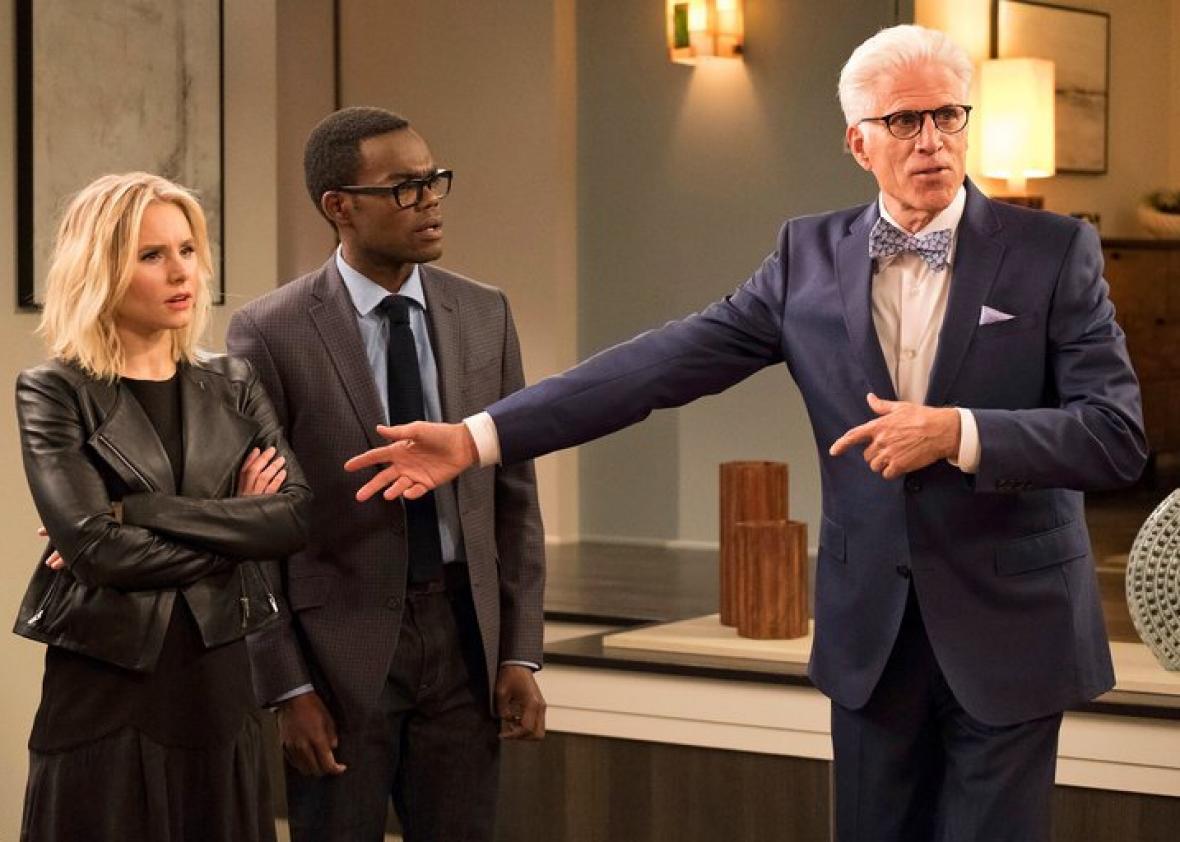On The Good Place, hell is other people’s heaven. The first season of the NBC sitcom, created by Parks & Recreation’s Mike Schur, plopped snake-oil saleswoman Eleanor Shellstrop (Kristen Bell) into an idyllic afterlife populated by moral paragons, the apparent result of an administrative glitch confusing her with a different, far more admirable, Eleanor. Given that her discovery would have meant a one-way ticket to the Bad Place, Eleanor waged an increasingly panicked campaign to pass herself off as someone who actually belonged in heaven, only to discover—spoiler!—that she was already in hell, of a particularly fiendish variety cooked up by Ted Danson’s genial demon, Michael. Along with Chidi (William Jackson Harper), a moral philosopher so caught up in his own dilemmas he neglected in life to actually do much good, Tahani (Jameela Jamil), a would-be celebutante whose charitable fundraising was all at the service of her own narcissism, and Jason (Manny Jacinto) a dopey DJ who believes he’s been mistaken for a Buddhist monk, Eleanor was part of a test group specially chosen for their ability to drive each other crazy, their less admirably personal characteristics brought to the fore by the nagging feeling that they didn’t belong. The Good Place is perfect by definition, so if there was a problem, it had to be them.
The Good Place’s first season ended with Eleanor sussing out that the Good Place’s apparent flaws were a feature and not a bug: For a woman who made a living as a swindler, spending eternity under the threat of being found out was the ultimate torment. But her victory was short-lived, as victories over immortal and all-powerful beings tend to be: Michael wiped the foursome’s memories clean and started over, “rebooting” the Good Place with new few features designed to make sure she didn’t stumble on its secret a second time.
In the show’s second season, that’s easier said than done. The hour-long first episode, which airs on NBC tonight, introduces its doomed characters to a new array of fiendishly passive-aggressive torments. Eleanor’s new soulmate is a hunky dope who rushes off to the gym every time she tries to engage him in conversation; the luxe-loving Tahani is condemned to a one-floor bungalow with an abstemious mate who still thinks it’s more space than they need. This time, however, we’re watching their struggles from behind the curtain, and we’re in on Michael’s interactions with the rest of the Good Place’s inhabitants, all of whom are demons in on the gag.
The Good Place’s first season was subtly informed by the absurdity of addressing weighty moral questions in the form of a network sitcom, and its second takes the meta to new levels: Tiya Sircar, a demon who played the part of the “real” Eleanor whom Bell’s character had displaced, is cast this time around as Denise, the nondescript owner of a neighborhood pizza joint. (This being hell, the only kind of pizza they serve is Hawaiian.) She’s not especially happy with her new role, and when she complains to Michael, she’s like an ambitious starlet pushing for a juicier part: “I am a Ferrari, and you don’t keep a Ferrari in the garage.” Explaining to his boss how the new Good Place will differ from the first, Michael says, “We kept everything that annoyed them … and added a bunch of new stuff,” which could almost be a line from a showrunner’s second-season pitch.
The Good Place has kept the first season’s good stuff, including D’Arcy Carden’s preternaturally peppy Janet, a personified help-desk program who appears with unnerving rapidity whenever she’s summoned, and its brisk mixture of intellectual humor and lowbrow puns. (The Hawaiian pizza parlor is named Hawaii 5-Dough.) But it’s cannily switched its interpersonal dynamics so that Eleanor and her fellow Good Place inhabitants are no longer antagonists but part of a unit. Although their minds are wiped, the four retain vestigial memories of one another that draw them ineluctably to discovering Michael’s grand plan. (That’s especially true of Eleanor and Chidi, whose antagonism must by the laws of sitcoms eventually develop into love.) As Michael tries to steer them toward self-torture, they’re forged into a team, even if they can’t remember the game that they’re playing.
The second season begins with Michael’s second attempt, but it quickly goes the same way as the first, and in the four episodes provided to critics in advance, the number of iterations quickly grows into the hundreds. Although Eleanor, Chidi, Tahani, and Jason aren’t exactly good people, they’re not quite bad enough to deserve the hell to which they’ve been condemned, and some as-yet-unidentified quirk in the makeup of the afterlife seems compelled to recognize that. Michael chuckles when Chidi tells him he thought heaven would mean endless conversations with Kant and Foucault; they’re in the bad place, too. But if history’s greatest thinkers couldn’t figure out how to live a righteous life, who can? The Good Place spends its first season revealing how people who seem to be good can actually be bad, but it hasn’t really explored what real goodness would look like. The second season might finally take us to a place that’s actually good.
